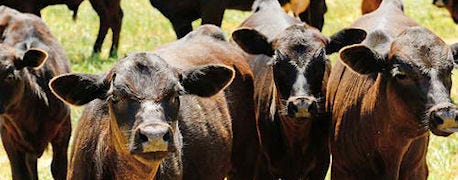
Friday's USDA Cattle on Feed Report confirms that beef supplies will stay tight going forward. How Monday's markets open depends on whether traders sense that this week's rally already built enough of the supply crunch into the price recovery.
While key numbers did come in on the negative side of trade guesses, the differences are small. Looking at the numbers, USDA pegged:
• July placements at 1.560 million head, up 34,000 from the average trade guess.
• July marketings at 1.787 million head, 75,000 below the average trade guess.
• Cattle on feed Aug. 1 at 9.837 million were 63,000 more than trade guesses.

Traders rallied futures going into USDA's Cattle on Feed Report; A return of pessimism would stall Friday's attempt at recovery.
The deviations are not large. The unexpected extra 63,000 cattle on feed are roughly half a day's normal slaughter.
Placements are always the wild card. Placements are also the most crucial because they provide early clues on number of fed cattle that will come to the slaughter market down the road.
While the 1.560 million cattle placed in July were higher than the trade expected, they were still down from 1.684 million a year ago. That's another major reduction considering that July 2013 placements were relatively light. Last month's placements were the smallest for July since USDA started the current data series in 1996.
After a string of larger-than-year earlier placements in late 2013 and early 2014, July now represents the fifth straight month with placements lower than the same month a year ago.

From another angle March through July feedlots placed 523,000 fewer cattle compared to those five months a year ago. The forces driving lower placements include:
• A squeaky-tight supply of feeder cattle outside of feedlots due to smaller calf crops.
• Good, or at least better, grazing conditions over a large swath of cow-calf country relative to recent years.
• Producers retaining heifers for herd expansion.
However, better grazing conditions encourage producers to keep feeder cattle on pasture longer. Delaying placements means relatively more feeder cattle might be available to place later. Feeders that stay on grass longer eventually go into feed yards at heavier weights. Thus delaying placements may not shift fed cattle marketings as much as the raw placement numbers might suggest.
~~~PAGE_BREAK_HERE~~~
Feeder cattle retain solid support. Easing new-crop corn prices trim costs to feed cattle, which should support feeder cattle prices going forward.
The higher than expected placements could suggest cow-calf producers succumbed to the temptation to bank money from feedlots now, rather than put heifers in the breeding herd to expand production later.
Steve Meyer, Paragon Economics, Adel, Iowa, points out some other forces that help buoy placements:
• Placements in April, May and June were quite limited. Fewer cattle entering feedlots in those months left relatively more cattle available to place later.
• Feeder cattle prices hit all-time record highs in July, which some producers may have seen as an opportunity to sell and capture the premiums rather than roll the dice in the fall market.
• Declining feed costs give feedlots ample incentive to bid up and try to secure lighter calves.
Feeder cattle imports from Mexico were sharply higher in July.
"This last point is worth noting as it tends to bolster overall supplies in states such as Texas," he explains. "Weekly trade data suggest imports of feeder cattle from Mexico during the period June 29 - July 26 were 60,769 head, up about 24,328 head or 67% compared to the same period a year ago.
Imports of Canadian feeder cattle during the same period were 5,687 head, down about 1,560 head from a year ago. Overall feeder imports were almost 23,000 head higher than last year, which is about 1.5% of the total number of placements for the month of July.
About the Author(s)
You May Also Like




